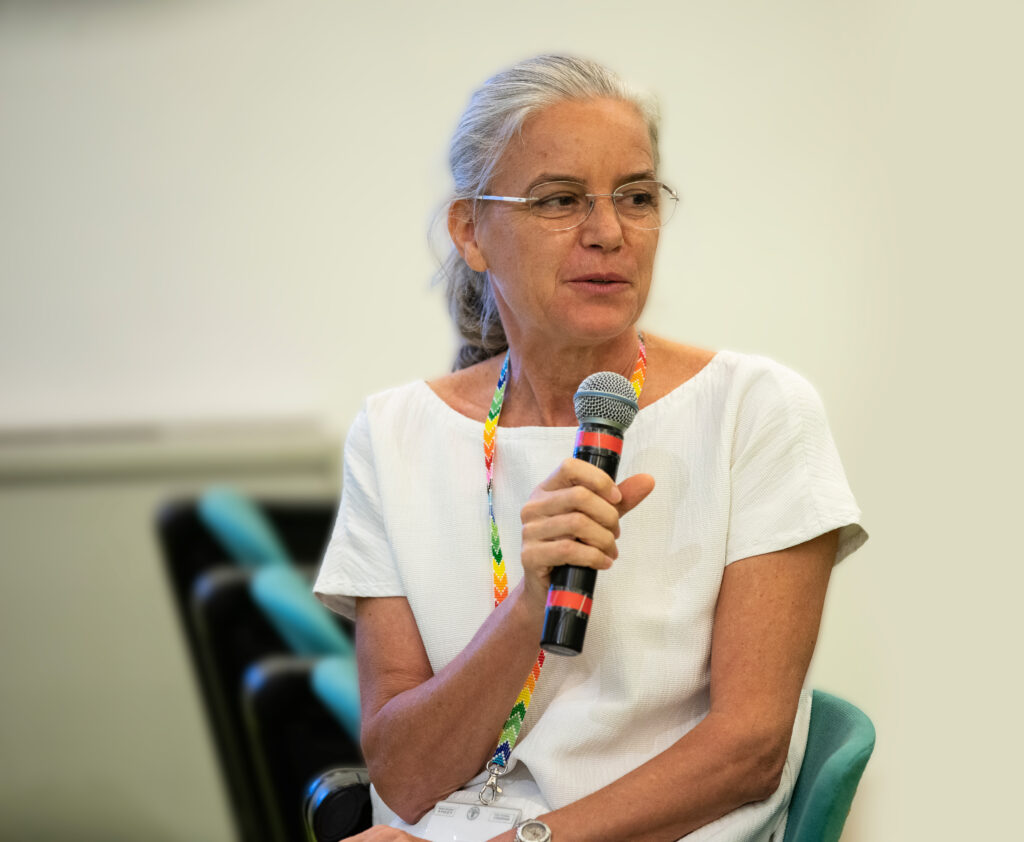
Name: Mette Løyche Wilkie
Title: Director (Retired), Forestry Division
Organization: Food and Agriculture Organization of the United Nations (FAO)
Role: Mette led the forestry programme of FAO, the UN agency responsible for agriculture, forestry, fisheries and food security. She managed an international team of 300 people to execute a $100M annual programme and project portfolio of half a billion dollars.
Education: BSc and MSc in Forest Management, The Royal Veterinary and Agricultural University (now part of University of Copenhagen), MSc in Environmental Management, Wye College, University of London.
Years in the field: 35
Women in Forest Policy
Early in my career, I was wooed at the thought of working in forest policy. As a young forester with strong ideals – I saw organizations such as the FAO, as being the place where you could make a difference. I became rather sidetracked by the private sector, and don’t get me wrong, I’m happy to be here – but I think the proverb, if you want to go fast, go alone. If you want to go far, go together aptly reflects the difference in these two spheres. Though attracted by the fast pace of the private sector, the ability to create lasting change at a global scale takes time and commitment and lies firmly in the realm of forest policy. Where the private sector can be quite solitary, driven by the competitiveness and protectiveness of business, the policy side of forestry carries a more altruistic, collective vision for forest stewardship.
My interview today with Mette Løyche Wilkie sums this up in her career. Mette was not only in the top forestry position in the FAO, leading an international team of 300 people, but she also served as the Chair of the Collaborative Partnership on Forests – a collaboration of 15 organizations with an international mandate on forests, and co-lead the planning and implementation of the UN Decade on Ecosystem Restoration. Over the 35 years of her career – she has gone far and has paid a great service to global forests and the people and environments that depend on them.
Taking a gender focus, a clear takeaway from my interview with Mette is the importance in demonstrating knowledge. As MaryKate said in my previous interview – “they don’t hand out buttons that say, this lady knows what she is doing” – However, when you have the opportunity to demonstrate what you know – take it. And no one will be able to argue. Another theme I’ve noticed over the past two articles is the influence of female mentorship. MaryKate spoke of her childhood idol, Jane Goodall and a female colleague who brought her on, while Mette speaks of an influential female teacher and one of her heroes, Wangari Maathai. I hope you enjoy this article and reading about Mette, a female role model for the forestry profession in her own right.
Not many can claim slowing global deforestation as a personal highlight of their career
I asked Mette what was the biggest accomplishment of her career, and with the humblest manner, she responded:
Mette: I think the fact that I have been able to help halt the rate of deforestation and help promote sustainable forest management at a global scale by leading the forestry program of FAO, is probably the main accomplishment over my career.
I commented that this is quite a substantial accomplishment, and she modestly indicated that her role was more in support of others, through giving them the guidance and information to protect, manage, and restore the world’s forests rather than doing it directly. However, it is only under outstanding leadership at the global level that this can be achieved.
Turning point from a female Mentor
Most of us can remember a time in our lives when an event, or conversation triggered a turning point for the course of our career. One of mine was in my first professional job out of university when I asked a female mentor and colleague what I should be wary of that could limit my professional opportunities. Though she probably didn’t think her response would have such a profound impact on my life – her advice to seek opportunity outside the box, and not be afraid to take chances, spurred me to quit that job, travel the world, seek forestry experience and education internationally and so on.
For Mette, this moment came when she was 15 years old.
Mette: In the Danish education system, when you are fifteen, you make the decision on whether you will focus on languages or science to complete your schooling. I was pretty good at languages – English, and German and I had taken Latin. This was in the mid-seventies where it was very common for girls to study languages, but I had a female math teacher – a bit unusual at the time – who said, “well you’re also good at math – why don’t you try sciences?” So, I had a chat with my Dad, and he said, “you can always go to another country and learn the language, but its very difficult to pick up math and physics afterwards”. They convinced me to take that route, and had I never chosen science, I would never have become a Forester. This was a decision very early on that shaped my career, and I don’t know if a male math teacher would have done the same back then…
Gender balance in forestry is improving
Taking the topic of gender balance in forestry, touched on in my initial women in the woods series article, and later in my discussion with MaryKate, I asked Mette how she experienced this. Mette described what it was like for her when she first started out. She explains how though men dominated the head count in her forestry education – she never felt that she was held back based on gender.
Mette: When I started studying forestry in 1979, we were 24 in my year, and there was one other woman, who quit after a couple of months. It was physically too hard for her to work in the woods. We were down to 18 after the first year, and by that point, I was used to being the only woman in the group.
I was on a forestry student committee together with another female forester from another year. The committee was putting out a prospectus to attract students to the faculty. It noted that at the time there was a handful of women who had completed the forestry education, stating that none of them were professionally in forestry, but two of them were married to foresters – the two of us very quickly removed this sentence and instead wrote why it would be interesting for women to study forestry. She then went on to become the first female district forest officer in Denmark and I went on to become leader of the forestry program at the UN! I graduated in 1986 and at that time, I was the 15th woman in Denmark to complete a forestry education, but by the time I graduated there were another 15 on their way.
When looking at the UN, the UN Secretary-General, António Guterres, issued a UN system-wide strategy on gender parity back in 2017 with targets for all UN organizations, so for those that are lagging behind in female representation, it is now an advantage being a woman – all else being equal. FAO has, for example, seen a big shift in the past 5-10 years, including in the Forestry Division where we achieved gender parity for all senior positions (Director level and Senior Professional Offices) by the time I left.
How demonstrating knowledge and honesty can break down gender barriers
Given the international setting of Mette’s work, I asked her if she faced any gender-related differences from her own culture, compared to other cultural settings she has worked in.
Mette:My first job after graduation was as an Associate Professional Officer working on an FAO forestry project in Sierra Leone, West Africa and of course it was a challenge to be a young (27-year-old) woman in a male-dominated profession in a country that – unlike mine – has such a reverence for its elders. Thankfully, the Danish forestry education at the time was very broad and very practical (in my view then it was old-fashioned including a year’s practical work in the forest, surveying and map drawing by hand and even road building..), so the fact that I was able to handle a chainsaw, undertake a forest inventory and calculate the magnetic deviation when we had to find a hidden boundary based on old maps, combined with an openness about my complete lack of knowledge of local tree species, greatly helped me and I was quickly accepted by both my Sierra Leonean and international colleagues. Since then, I don’t recall any problems related to gender during my career – other than having to say no to a really interesting short-term job in Bhutan as I was pregnant at the time, and it was in a rural area far from the capital with very difficult access.
Speaking of babies…
I asked Mette how she thinks having children impacted the trajectory of her career, how she has been able to maintain her family/work responsibilities and what was her biggest challenge in motherhood and career balance.
Mette: I have two sons, now 29 and 27. I made the conscious decision that I didn’t want to work full time while the kids were small. We were lucky enough that we could live off my husband’s salary. We were in the Philippines from when my oldest was born until he was about five. I then worked as a consultant part-time, but also decided that this was a good time to do a second masters through distance learning. So, when my kids were in the nursery for 3 hours in the morning, I would go to the nearest hotel and study. When they were about 4 and 6, we moved to Italy, and I started working full time. That of course was not easy. The first year, my husband was doing an MBA in Edinburgh, so I was on my own with two kids. We got an Au pair and relied on my mother to fly in from Denmark when I needed to go on mission. You always feel like you’re not giving 100% at work, nor giving 100% at home, but my kids both insist that they’ve had a wonderful childhood and I think we underestimate how resilient children are as long as they feel safe and loved and have a fairly regular daily routine.
Gender disparity in the local forest context
Knowing that FAO does a lot of work on the ground in the tropical developing geographies where I focus my work, I asked Mette in a word to describe the biggest challenge and the solution for achieving gender equality in these contexts.
Mette: The challenge is exclusion and of course the solution is inclusion. It is a lack of access in many cases for women – to information, funding, property rights, and education. They don’t have the same opportunities because they have not been given the same access. Huge efforts still need to be made through for example improving inheritance policies, tenure rights, and sustainable livelihood opportunities for single mothers or widows. We need to give women access to markets and earning potential, often only given to men. There are a number of interesting initiatives, The Grameen Bank, is an excellent pioneering example of this. [The Grameen Bank is a microfinance organisation and community development bank founded in Bangladesh].
Access to mobile phones has progressed inclusion, enabling women to band together and get directly in contact with the market and cut out middlemen, access extension services, such as knowing what to plant and when, and be able to transfer money.
How to rise to the top in the UN? – Go for it!
I asked Mette if she had any practical advice for young women aspiring to top leadership roles such as her role in the FAO, and she said with a big enthusiastic grin – Go for it! She quickly jumped into the more practical requirements for building a career in the UN.
Mette: There are three main requirements. The first is that you need an advanced relevant degree in whatever UN institution you are going to be working in. The second is that for most positions you need two of the UN languages: English, French, Spanish, Arabic, Chinese or Russian. The third is practical experience at the international level. It doesn’t have to be at the global level, but preferably in a country other than your home country and preferably in a developing country. To get this experience, internships, volunteering, Associate Professional Officer programs run by the UN and the UN Volunteers program are all relevant. For those interested in a job with the UN, I would suggest subscribing to the Impactpool newsletter, which contains a huge list of vacancies and helps you prepare for a career in the UN.
It is also important to build management experience, negotiation, and communication skills. Try to find a mentor or someone to talk to who is in this line of work. There are more and more female forestry leaders to learn from – one of my own heroes is the late Wangari Maathai. [Wangari Maathai was the first African woman to win the Nobel Peace Prize for her contribution to sustainable development, democracy and peace. She founded the Green Belt Movement where, she mobilized poor women to plant 30 million trees].
It was an absolute honour to speak with Mette and learn especially about the early days of her career and how gender equality has progressed in forestry. It was also encouraging to hear that she never faced any gender-related setbacks, case in point being that she rose to the top of the UN organization responsible for forestry. If you would like to get in contact with Mette, you can find her here. If you would like to share your thoughts on this series, please reach out.




